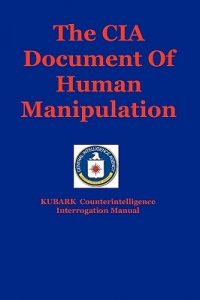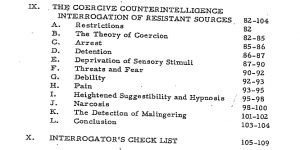
In this post we will take a look at the first of a series of books and articles that focus on what we might call “Weaponized Hypnosis”.
Most people are familiar with the use of Hypnosis by stage magicians (making a subject crow like a rooster or other stunt), and the practical use by clinicians to help people with addictions and trauma.
There are also video’s and podcasts that help people with self-improvement using simple tricks of re-routing information through the brain to achieve better results on everything from relationships to athletics. A good example can be found at the website of Mike Mandel, who has a very entertaining podcast found at this link:
http://mikemandelhypnosis.com/
There is, however, a dark side to Hypnosis that probably goes back thousands of years. Most recently, we can study declassified intelligence documents that explain how the CIA (in this example) suggested the use of hypnosis in the interrogation of prisoners. That document is called “KUBARK Counterintelligence Interrogation Manual”. The copy I have is in book format by www.mindcontrolpublishing.com, date of publishing unknown.
This copy does match the content of the declassified PDF of the actual report, available on line at this link:
According to the books publisher, “KUBARK” is a cryptonym used by the CIA when internally referring to the agency. While the field manual was published in 1963, the PDF document states that declassification was 2-25-2014.
The manual deals mostly with the nature of counterintelligence, but for this post we will look at the use of hypnosis in interrogation, which begins around page 95 in the book.

Here is the text:
l. ‘I-leightened Suggestibility and Hypnosis
In recent years a number of hypotheses about hypnosis
have been advanced by and others in the guise of
proven principles. Among these are the flat assertions that a
person connot be hypnotized against his will; that while
hypnotized he cannot be induced to divulge information that he
wants urgently to conceal; and that he will not undertake, in
trance or through post-hypnotic suggestion, actions to which
he would normally have serious moral or ethical objections.
If these and related contentions were proven valid, hypnosis
would have scant value for the interrogator.
But despite the fact that hypnosis has been an object of
scientific inquiry for a very long time, none of these theories
has yet been tested adequately. Each of them is in conflict
with some observations of fact. In any event, an interrogation
handbook cannot and need not include a discussion of
hypnosis. The case officer or interrogator needs to know
enough about the subject to understand the circumstances under
which hypnosis can be a useful tool, so that he can request
expert assistance appropriately.
Operational personnel, including interrogators, who
chance to have some lay experience or skill in hypnotism
should not themselves use hypnotic techniques for interrogation
or other operational purposes. There are two reasons for
this position. The first is that hypnotism used as an operational
tool by a practitioner who is not a.
or M. D. can produce irreversible damage. The
95
sac/{ET
Approved for Release: 2014/02/25
Approved for Release: 2014/02/25
lay practitioner does not know enough to use the technique
safely. The second reason is that an unsuccessful attempt
to hypnotize a subject for purposes of interrogation, or a
successful attempt not adequately covered by post-hypnotic
amnesia or other protection, can easily lead to lurid and
embarrassing publicity or legal charges.
Hypnosis is frequently called a state of heightened
suggestibility. but the phrase is a description rather than a
definition. Merton M. Gill and Margaret Brenman state,
“The theory of hypnosis clearly implies,
where it does not explicitly state, that hypnosis is a form
of regression.” And they add, . . inductionlof hypnosis]
is the process of bringing about a regression, while the
hypnotic state is the established regression.” (13) It is
suggested that the interrogator will find this definition the
most useful. The problem of overcoming the resistance
of an uncooperative interrogatee is essentially a problem
of inducing regression to a level at which the resistance
can no longer be sustained. Hypnosis is one way of
regressing people.
Martin T. Orne has written at some length about
hypnosis and interrogation. Almost all of his conclusions
are tentatively negative. Concerning the role played by the
will or attitude of the interrogatee, Orne says, “Although
the crucial experirnent has not yet been done, there is
little or no evidence to indicate that trance can be induced
against a person’s wishes.” He adds, . .the actual
occurrence of the trance state is related to the wish of
the subject to enter hypnosis.” And he also observes.
. .whether a subject will or will not enter trance depends
upon his relationship with the hyponotist rather than upon
the technical procedure of trance induction.” These
views are probably representative of those of many
but they are not definitive. As Orne
himself later points out, the interrogatee . . could be
given a hypnotic drug with appropriate verbal suggestions
to talk about a given topic. Eventually enough of the drug
96
Approved for Release: 2014/02/25
CO1297486
Approved for Release: 2014/02/25
would be given to cause a short period of unconsciousness.
When the subject wakesn, the interrogator could then read
from his ‘notes’ of the hypnotic interview the information
presumably told him. (Orne had previously pointed out
that this technique requires that the interrogator possess
significant information about the subject without the subject’s
knowledge.) “It can readily be seen how this. . . maneuver. . .
would facilitate the elicitation of information in subsequent
interviews.” (7) Techniques of inducing trance in resistant
subjects through preliminary administration of so-called
silent drugs (drugs which the subject does not know he has
-taken) or through other non-routine methods of induction
are still under investigation. Until more facts are known,
the question of whether a resister can be hypnotized involun-
tarily must go unanswered.
Orne also holds that even if a res ister can be
hypnotized, his resistance does not cease. He postulates
. . that only in rare interrogation subjects would a
sufficiently deep trance be obtainable to even attempt to
induce the subject to discuss material which he is unwilling
to discuss in the waking state. The kind of information which
can be obtained in these rare instances is still an unanswered
question.” He adds that it is doubtful that a subject in trance
could be made to reveal information which he wished to
safeguard. But here to.o Orne seems somewhat too cautious
or pessimistic. Once an interrogatee is in a hypnotic trance,
his understanding of reality becomes subject to rnanipulation.
For example, a KUBARK interrogator could tell a suspect
double agent in trance that the KGB is conducting the questioning,
and thus invert the whole frame of reference. In other words.
Orne is probably right in holding that most recalcitrant subjects
will continue effective resistance as long as the frame of
reference is undisturbed. But once the subject is tricked into
believing that he is talking to friend rather than foe, or that
divulging the truth is the best way to serve his own purposes,
his resistance will be replaced by cooperation. The value
of hypnotic trance is not that it permits the interrogator to
irnpose his will but rather that it can be used to convince the
interrogatee that there is no valid reason not to be forthcoming.
97
Approved for Release: 2014/02/25
Approved for Release: 2014/02/25
A third objection raised by.Orne and others is that
material elicited during trance is not reliable. Orne says,
. . it has been shown that the accuracy of such inforrnation. . .
would not be guaranteed since subjects in hypnosis are fully
capable of lying.” Again, the observation is correct; no known
manipulative method guarantees veracity. But if hypnosis
is employed not as an immediate instrument for digging out
the truth but rather as a way of making the subject want to
align himself with his interrogators, the objection evaporates.
Hypnosis offers one advantage not inherent in other
interrogation techniques or aids: the post-hypnotic suggestion.
Under favorable circumstances it should be possible to
administer a silent drug to a resistant source, persuade
him as the drug takes effect that he is slipping into a hypnotic
trance, place him under actual hypnosis as consciousness is
returning, shift his frame of reference so that his reasons
for resistance become reasons for cooperating, interrogate
him, and conclude the session by implanting the suggestion
that when he emerges from trance he will not remember
anything about what has happened.
This sketchy outline of possible uses of hypnosis in
the interrogation of resistant sources has no higher goal
than to remind operational personnel that the technique
may provide the answer to a problem not otherwise soluble.
To repeat: hypnosis is not a do-it-yourself project.
Therefore the interrogator, base, or center that is considering
its use must anticipate the timing sufficiently not only to secure
the obligatory headquarters permission but also to allow for an
expert’s travel time and briefing.
J. Narcosis
Just as the threat of pain may more effectively induce
compliance than its infliction, so an interrogatee’s mistaken
belief that he has been drugged may make him a more useful
interrogation subject than he would be under narcosis. Louis
A. cites a group of studies as indicating “that 30 to 50
per cent of individuals are placebo reactors, that is, respond
98
Approved for Release: 2014/02/25
———————————————————–
Take note that the manual suggests the use of a “silent’ drug, one that is possibly administered without the subject’s knowledge. It also describes inducing a hypnotic trance under the influence of the drug, with a post-hypnotic suggestion during the return to consciousness which would “shift his frame of reference so that his reason for resistance become reasons for cooperating”.
Coming up; we will look at other books and articles detailing use of hypnosis in interrogation and assassination.
-John Titus
See Part 2: The Manchurian Candidate
http://www.covertbookreport.com/weaponized-hypnosis-part-2-the-manchurian-candidate/

